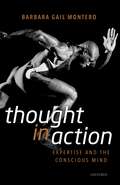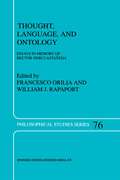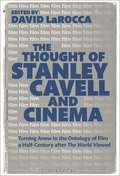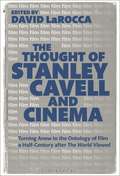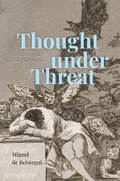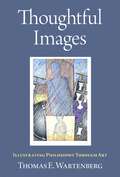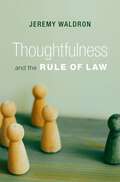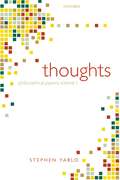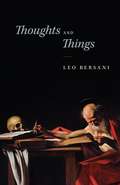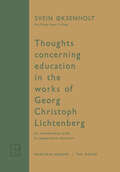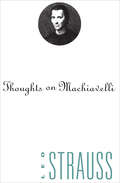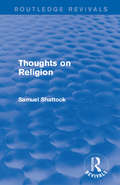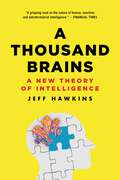- Table View
- List View
Thought in Action: Expertise and the Conscious Mind
by Barbara Gail MonteroHow does thinking affect doing? There is a widely held view—both in academia and in the popular press—that thinking about what you are doing, as you are doing it, hinders performance. Once you have acquired the ability to putt a golf ball, play an arpeggio on the piano, or parallel-park, reflecting on your actions leads to inaccuracies, blunders, and sometimes even utter paralysis—that's what is widely believed. Experts, according to this view, don't need to try to do it; they just do it. But is this true? After exploring some of the contemporary and historical manifestations of the idea that highly accomplished skills are automatic and effortless, Barbara Gail Montero develops a theory of expertise which emphasizes the role of the conscious mind in expert action. She aims to dispel various myths about experts who proceed without any understanding of what guides their action. (For example, that proverbial chicken sexer who can't explain why he makes his judgments? He simply doesn't exist.) Montero's critical task also involves analyzing research in both philosophy and psychology that is taken to show that conscious control and explicit monitoring of one's movements impedes well practiced skills. She explores a wide range of real-life examples of optimal performance-culled from sports, the performing arts, chess, nursing, medicine, the military and elsewhere-and draws from psychology, neuroscience, and literature to offer a refreshing and persuasive view of expertise, according to which expert action generally is and ought to be thoughtful, effortful, and reflective.
Thought, Language, and Ontology: Essays in Memory of Hector-Neri Castañeda (Philosophical Studies Series #76)
by Francesco Orilia W. J. RapaportThe Thought of Stanley Cavell and Cinema: Turning Anew to the Ontology of Film a Half-Century after The World Viewed
by David LaRoccaStanley Cavell was, by many accounts, America's greatest philosophical thinker of film. Like Bazin in France and Perkins in England, Cavell did not just transform the American capacity to take film as a subject for philosophical criticism; he had to first invent that legitimacy. Part of that effort involved the creation of several key now-canonical texts in film studies, among them the seminal The World Viewed along with Pursuits of Happiness and Contesting Tears. The present collection offers, for the first time anywhere, a concerted effort mounted by some of today's most compelling writers on film to take careful account of Cavell's legacy. The contributors think anew about what precisely Cavell contributed, what holds up, what is in need to revision or updating, and how his writing continues to be of vital significance and relevance for any contemporary approach to the philosophy of film.
The Thought of Stanley Cavell and Cinema: Turning Anew to the Ontology of Film a Half-Century after The World Viewed
Stanley Cavell was, by many accounts, America's greatest philosophical thinker of film. Like Bazin in France and Perkins in England, Cavell did not just transform the American capacity to take film as a subject for philosophical criticism; he had to first invent that legitimacy. Part of that effort involved the creation of several key now-canonical texts in film studies, among them the seminal The World Viewed along with Pursuits of Happiness and Contesting Tears. The present collection offers, for the first time anywhere, a concerted effort mounted by some of today's most compelling writers on film to take careful account of Cavell's legacy. The contributors think anew about what precisely Cavell contributed, what holds up, what is in need to revision or updating, and how his writing continues to be of vital significance and relevance for any contemporary approach to the philosophy of film.
Thought under Threat: On Superstition, Spite, and Stupidity
by Miguel de BeisteguiThought under Threat reveals and combats the forces diminishing the power and role of critical thinking, whether in our individual lives or collectively. Thought under Threat is an attempt to understand the tendencies that threaten thinking from within. These tendencies have always existed. But today they are on the rise and frequently encouraged, even in our democracies. People “disagree” with science and distrust experts. Political leaders appeal to the hearts and guts of “the people,” rather than their critical faculties. Stupidity has become a right, if not a badge of honor; superstition is on the rise; and spite is a major political force. Thinking is considered “elitist.” To see those obstacles as vices of thought, Miguel de Beistegui argues, we need to understand stupidity not as a lack of intelligence or judgment, but as the tendency to raise false problems and trivial questions. Similarly, we need to see spite not as a moral vice, but as a poison that blurs and distorts our critical faculties. Finally, superstition is best described not as a set of false beliefs, but as a system that neutralizes one’s ability to think for oneself. For de Beistegui, thinking is intrinsically democratic and a necessary condition for the exercise of freedom. Thought under Threat shows how a training of thought itself can be used to ward off those vices, lead to productive deliberation, and, ultimately, create a thinking community.
Thought under Threat: On Superstition, Spite, and Stupidity
by Miguel de BeisteguiThought under Threat reveals and combats the forces diminishing the power and role of critical thinking, whether in our individual lives or collectively. Thought under Threat is an attempt to understand the tendencies that threaten thinking from within. These tendencies have always existed. But today they are on the rise and frequently encouraged, even in our democracies. People “disagree” with science and distrust experts. Political leaders appeal to the hearts and guts of “the people,” rather than their critical faculties. Stupidity has become a right, if not a badge of honor; superstition is on the rise; and spite is a major political force. Thinking is considered “elitist.” To see those obstacles as vices of thought, Miguel de Beistegui argues, we need to understand stupidity not as a lack of intelligence or judgment, but as the tendency to raise false problems and trivial questions. Similarly, we need to see spite not as a moral vice, but as a poison that blurs and distorts our critical faculties. Finally, superstition is best described not as a set of false beliefs, but as a system that neutralizes one’s ability to think for oneself. For de Beistegui, thinking is intrinsically democratic and a necessary condition for the exercise of freedom. Thought under Threat shows how a training of thought itself can be used to ward off those vices, lead to productive deliberation, and, ultimately, create a thinking community.
Thoughtful Images: Illustrating Philosophy Through Art
by Thomas E. WartenbergThoughtful Images demonstrates that there is a rich tradition of illustrations of philosophy that originated in Ancient Greece, spread throughout Europe, thrived in twentieth century America, and continues to this day. It is the first book to isolate this tradition and to explain its relevance for both philosophy and art. It's not surprising that philosophers and others have not acknowledged the existence of this artistic tradition. Illustration is not generally regarded as a genuine art form on a par with painting and sculpture and many believe that the abstract claims made by philosophers are not amenable to being rendered in visual images. Wartenberg shows that the denigration of illustration as an art form is misguided in a number of ways. The book argues that great works of art such as Titian's Rape of Europa are actually illustrations of literary texts-Ovid's Metamorphoses in Titian's case. This undermines the attempt to diminish the artistic achievement of illustrations by seeing them as an inferior art form to painting. That the abstract claims and theories put forward by philosophers are amenable to illustration is supported by the examples discussed in the balance of the book. These examples include illuminated Medieval manuscripts featuring illustrations of Aristotle's ethical theories; the frontispieces of philosophical works in the 17th and 18th century; Friedrich Nietzsche's, Martin Heidegger's, and Michel Foucault's use of paintings to illustrate their theories; the modernist tradition in which art is seen as a form of philosophy; conceptual artists' creation of works that explicitly include ideas taken from Ludwig Wittgenstein's writings; and works of what the author calls "graphic philosophy"-comic books that include visual representations of philosophical ideas.
Thoughtful Images: Illustrating Philosophy Through Art
by Thomas E. WartenbergThoughtful Images demonstrates that there is a rich tradition of illustrations of philosophy that originated in Ancient Greece, spread throughout Europe, thrived in twentieth century America, and continues to this day. It is the first book to isolate this tradition and to explain its relevance for both philosophy and art. It's not surprising that philosophers and others have not acknowledged the existence of this artistic tradition. Illustration is not generally regarded as a genuine art form on a par with painting and sculpture and many believe that the abstract claims made by philosophers are not amenable to being rendered in visual images. Wartenberg shows that the denigration of illustration as an art form is misguided in a number of ways. The book argues that great works of art such as Titian's Rape of Europa are actually illustrations of literary texts-Ovid's Metamorphoses in Titian's case. This undermines the attempt to diminish the artistic achievement of illustrations by seeing them as an inferior art form to painting. That the abstract claims and theories put forward by philosophers are amenable to illustration is supported by the examples discussed in the balance of the book. These examples include illuminated Medieval manuscripts featuring illustrations of Aristotle's ethical theories; the frontispieces of philosophical works in the 17th and 18th century; Friedrich Nietzsche's, Martin Heidegger's, and Michel Foucault's use of paintings to illustrate their theories; the modernist tradition in which art is seen as a form of philosophy; conceptual artists' creation of works that explicitly include ideas taken from Ludwig Wittgenstein's writings; and works of what the author calls "graphic philosophy"-comic books that include visual representations of philosophical ideas.
Thoughtfulness and the Rule of Law
by Jeremy WaldronAn essential study of the rule of law by one of the world’s leading liberal political and legal philosophers.The meaning and value of the rule of law have been debated since antiquity. For many, the rule of law has become the essence of good government. But Jeremy Waldron takes a different view, arguing that it is but one star in a constellation of ideals that define our political morality, ranking alongside democracy, human rights, economic freedom, and social justice.This timely essay collection, from one of the most respected political philosophers of his generation, is a brief on behalf of thoughtfulness: the intervention of human intelligence in the application of law. Waldron defends thoughtfulness against the claim that it threatens to replace the rule of law with the arbitrary rule of people. To the contrary, he argues, the rule of law requires thoughtfulness: it is impossible to apply a standard such as “reasonableness” on the basis of rules alone, and common legal activities like arguing in court and reasoning from precedents are poorly served by algorithmic logics. This rich compilation also addresses the place of law in protecting human dignity, the relation between rule of law and legislation, and whether vagueness in the law is at odds with law’s role in guiding action.Thoughtfulness and the Rule of Law emphasizes the value of procedures rather than the substance or outcome of legal decisions. Challenging the view that predictability and clarity are cardinal virtues, Waldron shows that real-world controversies often are best approached using a relatively thin concept of the rule of law, together with the thoughtfulness that a legal system frames and enables.
Thoughts: Papers On Mind, Meaning, And Modality
by Stephen YabloThoughts is a collection of twelve essays by Stephen Yablo which together constitute a modern-day examination of Cartesian themes in the metaphysics of mind. Yablo offers penetrating discussions of such topics as the relation between the mental and the physical, mental causation, the possibility of disembodied existence, the relation between conceivability and possibility, varieties of necessity, and issues in the theory of content arising out of the foregoing. The collection represents almost all of Yablo's work on these topics, and features one previously unpublished piece.
Thoughts and Things
by Leo BersaniLeo Bersani’s career spans more than fifty years and extends across a wide spectrum of fields—including French studies, modernism, realist fiction, psychoanalytic criticism, film studies, and queer theory. Throughout this new collection of essays that ranges, interestingly and brilliantly, from movies by Claire Denis and Jean-Luc Godard to fiction by Proust and Pierre Bergounioux, Bersani considers various kinds of connectedness. Thoughts and Things posits what would appear to be an irreducible gap between our thoughts (the human subject) and things (the world). Bersani departs from his psychoanalytic convictions to speculate on the oneness of being—of our intrinsic connectedness to the other that is at once external and internal to us. He addresses the problem of formulating ways to consider the undivided mind, drawing on various sources, from Descartes to cosmology, Freud, and Genet and succeeds brilliantly in diagramming new forms as well as radical failures of connectedness. Ambitious, original, and eloquent, Thoughts and Things will be of interest to scholars in philosophy, film, literature, and beyond.
Thoughts and Things
by Leo BersaniLeo Bersani’s career spans more than fifty years and extends across a wide spectrum of fields—including French studies, modernism, realist fiction, psychoanalytic criticism, film studies, and queer theory. Throughout this new collection of essays that ranges, interestingly and brilliantly, from movies by Claire Denis and Jean-Luc Godard to fiction by Proust and Pierre Bergounioux, Bersani considers various kinds of connectedness. Thoughts and Things posits what would appear to be an irreducible gap between our thoughts (the human subject) and things (the world). Bersani departs from his psychoanalytic convictions to speculate on the oneness of being—of our intrinsic connectedness to the other that is at once external and internal to us. He addresses the problem of formulating ways to consider the undivided mind, drawing on various sources, from Descartes to cosmology, Freud, and Genet and succeeds brilliantly in diagramming new forms as well as radical failures of connectedness. Ambitious, original, and eloquent, Thoughts and Things will be of interest to scholars in philosophy, film, literature, and beyond.
Thoughts and Things
by Leo BersaniLeo Bersani’s career spans more than fifty years and extends across a wide spectrum of fields—including French studies, modernism, realist fiction, psychoanalytic criticism, film studies, and queer theory. Throughout this new collection of essays that ranges, interestingly and brilliantly, from movies by Claire Denis and Jean-Luc Godard to fiction by Proust and Pierre Bergounioux, Bersani considers various kinds of connectedness. Thoughts and Things posits what would appear to be an irreducible gap between our thoughts (the human subject) and things (the world). Bersani departs from his psychoanalytic convictions to speculate on the oneness of being—of our intrinsic connectedness to the other that is at once external and internal to us. He addresses the problem of formulating ways to consider the undivided mind, drawing on various sources, from Descartes to cosmology, Freud, and Genet and succeeds brilliantly in diagramming new forms as well as radical failures of connectedness. Ambitious, original, and eloquent, Thoughts and Things will be of interest to scholars in philosophy, film, literature, and beyond.
Thoughts and Things
by Leo BersaniLeo Bersani’s career spans more than fifty years and extends across a wide spectrum of fields—including French studies, modernism, realist fiction, psychoanalytic criticism, film studies, and queer theory. Throughout this new collection of essays that ranges, interestingly and brilliantly, from movies by Claire Denis and Jean-Luc Godard to fiction by Proust and Pierre Bergounioux, Bersani considers various kinds of connectedness. Thoughts and Things posits what would appear to be an irreducible gap between our thoughts (the human subject) and things (the world). Bersani departs from his psychoanalytic convictions to speculate on the oneness of being—of our intrinsic connectedness to the other that is at once external and internal to us. He addresses the problem of formulating ways to consider the undivided mind, drawing on various sources, from Descartes to cosmology, Freud, and Genet and succeeds brilliantly in diagramming new forms as well as radical failures of connectedness. Ambitious, original, and eloquent, Thoughts and Things will be of interest to scholars in philosophy, film, literature, and beyond.
Thoughts and Things
by Leo BersaniLeo Bersani’s career spans more than fifty years and extends across a wide spectrum of fields—including French studies, modernism, realist fiction, psychoanalytic criticism, film studies, and queer theory. Throughout this new collection of essays that ranges, interestingly and brilliantly, from movies by Claire Denis and Jean-Luc Godard to fiction by Proust and Pierre Bergounioux, Bersani considers various kinds of connectedness. Thoughts and Things posits what would appear to be an irreducible gap between our thoughts (the human subject) and things (the world). Bersani departs from his psychoanalytic convictions to speculate on the oneness of being—of our intrinsic connectedness to the other that is at once external and internal to us. He addresses the problem of formulating ways to consider the undivided mind, drawing on various sources, from Descartes to cosmology, Freud, and Genet and succeeds brilliantly in diagramming new forms as well as radical failures of connectedness. Ambitious, original, and eloquent, Thoughts and Things will be of interest to scholars in philosophy, film, literature, and beyond.
Thoughts and Things
by Leo BersaniLeo Bersani’s career spans more than fifty years and extends across a wide spectrum of fields—including French studies, modernism, realist fiction, psychoanalytic criticism, film studies, and queer theory. Throughout this new collection of essays that ranges, interestingly and brilliantly, from movies by Claire Denis and Jean-Luc Godard to fiction by Proust and Pierre Bergounioux, Bersani considers various kinds of connectedness. Thoughts and Things posits what would appear to be an irreducible gap between our thoughts (the human subject) and things (the world). Bersani departs from his psychoanalytic convictions to speculate on the oneness of being—of our intrinsic connectedness to the other that is at once external and internal to us. He addresses the problem of formulating ways to consider the undivided mind, drawing on various sources, from Descartes to cosmology, Freud, and Genet and succeeds brilliantly in diagramming new forms as well as radical failures of connectedness. Ambitious, original, and eloquent, Thoughts and Things will be of interest to scholars in philosophy, film, literature, and beyond.
Thoughts Concerning Education in the Works of Georg Christoph Lichtenberg: An Introductory Study in Comparative Education
by Svein OksenholtThis is an investigation of the thoughts concerning education in the writings of one of the most original educators of the eighteenth century. Unappreciated and largely overlooked - as was Schopenhauer - by the contemporary educators, Lichtenberg nevertheless presented his generation, and generations to come, with some of the most useful (a great life aim of Horace Mann!) suggestions pertaining to education that may possibly be found anywhere in the annals of classical edu cation. Beginning with a biographical sketch of Lichtenberg, it presents an analysis of his philosophy of education, discusses Lichtenberg's thoughts on pedagogy and curriculum, analyzes his conception of morals and religion to the extent that these ideas are specifically related to education, examines his notions of educational psychology, determines Lichtenberg's views on British education in the eighteenth century, compares some of Lichtenberg's educational ideas in the works of contemporary thinkers and educators, notably Schopenhauer, James and Dewey. A concomitant aspect of this book is a portrayal of Lichtenberg as found in his works, viz., as a student, professor, philosopher, educator, moralist, psychologist, comparative educationist, as a searcher for absolute educational truth - attainable only in a world to come. SVEIN 0KSENHOLT, PH. D.
Thoughts on Machiavelli
by Leo StraussLeo Strauss argued that the most visible fact about Machiavelli's doctrine is also the most useful one: Machiavelli seems to be a teacher of wickedness. Strauss sought to incorporate this idea in his interpretation without permitting it to overwhelm or exhaust his exegesis of The Prince and the Discourses on the First Ten Books of Livy. "We are in sympathy," he writes, "with the simple opinion about Machiavelli [namely, the wickedness of his teaching], not only because it is wholesome, but above all because a failure to take that opinion seriously prevents one from doing justice to what is truly admirable in Machiavelli: the intrepidity of his thought, the grandeur of his vision, and the graceful subtlety of his speech." This critique of the founder of modern political philosophy by this prominent twentieth-century scholar is an essential text for students of both authors.
Thoughts on Machiavelli
by Leo StraussLeo Strauss argued that the most visible fact about Machiavelli's doctrine is also the most useful one: Machiavelli seems to be a teacher of wickedness. Strauss sought to incorporate this idea in his interpretation without permitting it to overwhelm or exhaust his exegesis of The Prince and the Discourses on the First Ten Books of Livy. "We are in sympathy," he writes, "with the simple opinion about Machiavelli [namely, the wickedness of his teaching], not only because it is wholesome, but above all because a failure to take that opinion seriously prevents one from doing justice to what is truly admirable in Machiavelli: the intrepidity of his thought, the grandeur of his vision, and the graceful subtlety of his speech." This critique of the founder of modern political philosophy by this prominent twentieth-century scholar is an essential text for students of both authors.
Thoughts on Machiavelli
by Leo StraussLeo Strauss argued that the most visible fact about Machiavelli's doctrine is also the most useful one: Machiavelli seems to be a teacher of wickedness. Strauss sought to incorporate this idea in his interpretation without permitting it to overwhelm or exhaust his exegesis of The Prince and the Discourses on the First Ten Books of Livy. "We are in sympathy," he writes, "with the simple opinion about Machiavelli [namely, the wickedness of his teaching], not only because it is wholesome, but above all because a failure to take that opinion seriously prevents one from doing justice to what is truly admirable in Machiavelli: the intrepidity of his thought, the grandeur of his vision, and the graceful subtlety of his speech." This critique of the founder of modern political philosophy by this prominent twentieth-century scholar is an essential text for students of both authors.
Thoughts on Machiavelli
by Leo StraussLeo Strauss argued that the most visible fact about Machiavelli's doctrine is also the most useful one: Machiavelli seems to be a teacher of wickedness. Strauss sought to incorporate this idea in his interpretation without permitting it to overwhelm or exhaust his exegesis of The Prince and the Discourses on the First Ten Books of Livy. "We are in sympathy," he writes, "with the simple opinion about Machiavelli [namely, the wickedness of his teaching], not only because it is wholesome, but above all because a failure to take that opinion seriously prevents one from doing justice to what is truly admirable in Machiavelli: the intrepidity of his thought, the grandeur of his vision, and the graceful subtlety of his speech." This critique of the founder of modern political philosophy by this prominent twentieth-century scholar is an essential text for students of both authors.
Thoughts on Man
by William GodwinTHOUGHTS ON MAN HIS NATURE, PRODUCTIONS AND DISCOVERIES INTERSPERSED WITH SOME PARTICULARS RESPECTING THE AUTHOR
Thoughts on Religion (Routledge Revivals)
by Samuel ShattockThis book, first published in 1926, is a collection of the original thoughts of Samuel George Shattock on religious matters. Shattock recorded his thoughts on religion throughout his life. This title brings together what Shattock himself felt to be his most important ideas on theology. Thoughts on Religion will be of interest to students of religion and philosophy.
Thoughts on Religion (Routledge Revivals)
by Samuel ShattockThis book, first published in 1926, is a collection of the original thoughts of Samuel George Shattock on religious matters. Shattock recorded his thoughts on religion throughout his life. This title brings together what Shattock himself felt to be his most important ideas on theology. Thoughts on Religion will be of interest to students of religion and philosophy.
A Thousand Brains: A New Theory of Intelligence
by Jeff HawkinsA bestselling author, neuroscientist, and computer engineer unveils a theory of intelligence that will revolutionize our understanding of the brain and the future of AI. For all of neuroscience's advances, we've made little progress on its biggest question: How do simple cells in the brain create intelligence? Jeff Hawkins and his team discovered that the brain uses maplike structures to build a model of the world-not just one model, but hundreds of thousands of models of everything we know. This discovery allows Hawkins to answer important questions about how we perceive the world, why we have a sense of self, and the origin of high-level thought. A Thousand Brains heralds a revolution in the understanding of intelligence. It is a big-think book, in every sense of the word.
